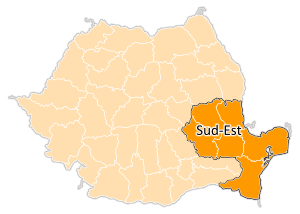Sud-Est (development region) facts for kids
Quick facts for kids
Sud-Est
|
|
|---|---|
|
Region
|
|
 |
|
| Country | |
| Capital city | Constanţa |
| Area | |
| • Total | 35,762 km2 (13,808 sq mi) |
| Population
(2011)
|
|
| • Total | 2,529,038 |
| • Density | 70.7186/km2 (183.1603/sq mi) |
| Ethnic groups | |
| • Romanians | 95.2% |
| • Roma | 1.7% |
| • Turks | 1.0% |
| • Lippovans | 0.9% |
| Time zone | UTC+2 (EET) |
| • Summer (DST) | UTC+3 (EEST) |
| NUTS code | RO22 |
| GDP per capita (PPS) | € 9,700 (2008) |
| Website | http://www.adrse.ro/ |
Sud-Est (which means South East) is an important development region located in Romania. These regions are like groups of counties that work together to help their area grow and improve. Sud-Est is one of the eight such regions in Romania.
This region is known for its diverse population and its connection to the Black Sea coast, which makes it a popular spot for tourism.
Contents
What Counties Make Up Sud-Est?
The Sud-Est region is made up of six different counties. Each county has its own unique features and contributes to the overall character of the region.
| County | Population in 2011 |
|---|---|
| Brăila | 316,893 |
| Buzău | 440,347 |
| Constanța | 680,945 |
| Galaţi | 539,721 |
| Tulcea | 211,622 |
| Vrancea | 339,510 |
| Total | 2,529,038 |
As you can see from the table, Constanța has the largest population among the counties in Sud-Est. The total population of the Sud-Est region was over 2.5 million people in 2011, making it the most populated development region in Romania at that time.
People and Cultures in Sud-Est
The Sud-Est region is home to many different groups of people, making it a place with a rich mix of cultures.
Main Ethnic Groups
Most of the people living in Sud-Est are Romanians, making up about 95.2% of the population. However, there are also other important ethnic groups:
- Roma: About 1.7% of the population.
- Turks: About 1.0% of the population.
- Lippovans: About 0.9% of the population.
This mix of cultures adds to the unique feel of the region.
Economy and Development
Development regions like Sud-Est are created to help different parts of Romania grow economically. This means they work on projects to improve jobs, infrastructure (like roads and buildings), and the overall quality of life for people living there.
Economic Strength
In 2008, the Gross Domestic Product (GDP) per person in Sud-Est was about €9,700. GDP is a way to measure how much money is made in a region. This number helps show the economic strength and development level of the area.
Time Zone Information
The Sud-Est region follows the same time zones as the rest of Romania.
- Standard Time: EET (UTC+2). This means it's 2 hours ahead of Coordinated Universal Time.
- Daylight Saving Time: During the summer, they switch to EEST (UTC+3). This means the clocks move forward by one hour, making it 3 hours ahead of Coordinated Universal Time.
See also
 In Spanish: Sud-Est (Región de desarrollo) para niños
In Spanish: Sud-Est (Región de desarrollo) para niños

